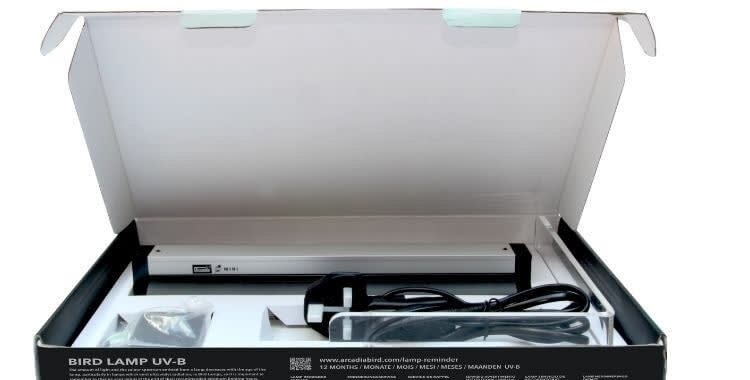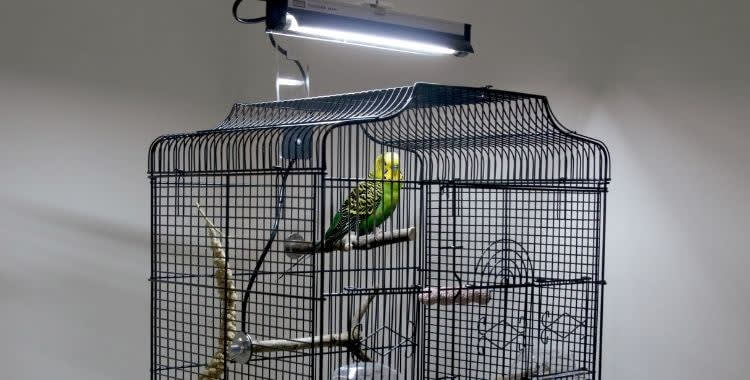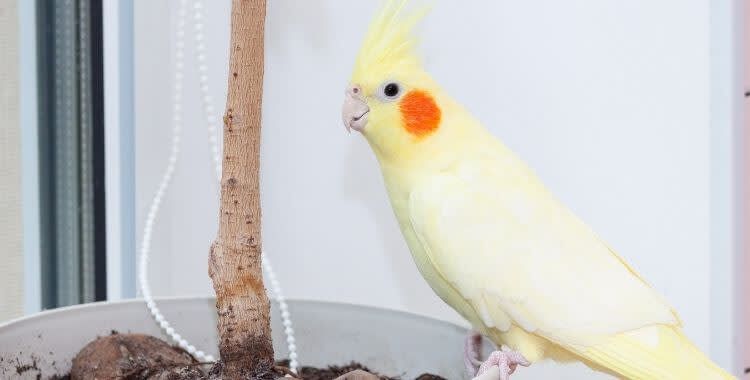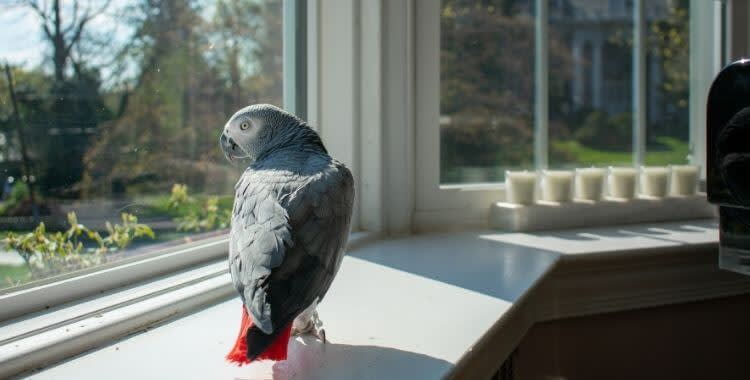Not all lamps are the same, regardless of their name or marketing. It is completely legal to sell ‘full-spectrum’ or ‘daylight’ lamps, be they tungsten, fluorescent or LED, that cannot produce UV.
Is your parrot insured? Get a quote for up to £5,000 of vet fee cover, death and theft cover | We’ve been insuring exotic pets since 1996 | Check out our customer reviews on Feefo.
How to use a bird lamp | How light spreads from the source | Enabling your bird to self regulate | Common types of bird lamp | Importance of positioning | Lamp replacement | UV safety
John Courteney-Smith MRSB FLS is Head of Science and Innovation at Arcadia Reptile and David Alderton is an expert in reptile and pet care.
Not all lamps are the same, regardless of their name or marketing. It is completely legal to sell ‘full-spectrum’ or ‘daylight’ lamps, be they tungsten, fluorescent or LED, that cannot produce UV.
A lamp only has to produce a colour of light that is similar to natural daylight, to be described in these terms.
For birds to see their environment in full colour and to be able to regulate their D3 production they require adequate UV-A as highlighted in articles part one and part two.
They must also have adequate UV-B provision for manufacturing their own Vitamin D3, that benefits both the preen gland and feathers.
 Check what you are buying – not all lamps are the same!
Check what you are buying – not all lamps are the same!
A lamp that produces the correct light will have a high Colour Rendering Index (CRI) and will display the legal warning triangle denoting the inclusion of UV.
Unfortunately, specialist lamps of this type are not cheap to manufacture or buy. They require rare earth phosphors and specialist crystal glass.
Inexpensive lamps may not include UV, may be manufactured with a cheaper phosphor mix or may not be properly balanced, meaning natural body processes cannot occur.
 Pure Sun Mini shown here – a suitable lamp, reflector and placement of the unit on the cage for a budgerigar.
Pure Sun Mini shown here – a suitable lamp, reflector and placement of the unit on the cage for a budgerigar.
How to use a bird lamp
Typically, specialist bird lamps have been designed to be fitted at approximately 25-38cm (10-15ins) above the bird’s head, when it is sitting on its uppermost perch.
Assuming the lamp is fitted correctly and at the right distance, the bird can experience the lamp’s energy as intended, in a safe and effective way.
But of course, birds have wings, feet and an inquisitive mind! All of which need to be taken into account when fitting an effective lighting system.
It does not matter if your bird flies or climbs closer than the distance of 25cm momentarily, as there will be no risk of over-exposure under these circumstances.
However this would be a very real danger if a bird was confined to a small cage with a lamp fitted over its entire quarters, meaning it could not move away from the light source.
If a UV lamp is located too close to a bird that cannot move away, there is a risk that it could suffer both sunburn and eye damage.
Should the lamp be fitted too far away from the bird and its perches, then it will also not benefit.
Simply adding a bird lamp into a bird room or living room will not be adequate. The correct positioning is vital.
How light spreads from the source
The total energy output of a lamp can be thought of as 100% at source. However, the further the lamp is from its target, the wider the beam becomes meaning a drop in energy..
Lamps are also cylindrical in nature, emitting light all around themselves. It means that roughly 60-70% of the energy produced by a lamp is travelling in the wrong direction, away from the bird!
It is therefore very important to choose a suitable reflector to use with the lamp that directs the rays downwards. This also reduces light overspill into the room.
Enabling your bird to self-regulate
Full-spectrum+UV-B lighting should only provided within an area of a cage that provides shaded areas.
Perches should be placed at as many locations within the cage as possible, without cluttering it. Self-regulation is key.
Birds will naturally take what they require from the lamp and then move to another location, often more shaded.
All birds living indoors without access to natural sunlight will benefit from this type of specialist lighting.
 A Lutino cockatiel (Nymphicus hollandicus) is seen here.
A Lutino cockatiel (Nymphicus hollandicus) is seen here.
Some practical examples of bird lamp use
-
- Budgie: A pet budgie kept in a wire cage that is 45cm (18ins) wide, 60cm (24ins) high and 45cm (18ins) deep could be provided with an 8 watt lamp that is 30cm (12ins) long.This will light almost all the width of the cage but will offer shade towards the bottom.
Macaws: A keeper with one or two large macaws in a cage that is both 1.8m (6ft) tall and wide would use a 1.2m (4ft) 54W T5 linear lamp.
A keeper could use two lamps to increase the width of projection.
The lamps’ footprint would cover both birds as they bask, with 0.6m (2ft) cage width offering a graduation to shade, as would its depth.
- African grey: A pet owner with an African grey parrot living in a cage that is 0.9m (3ft) wide and 1.2m (4ft) tall could use an E27 compact lamp or a 24W power compact (ParrotPro).Both would provide well and allow natural self-regulation, with an adequate drop off into shade.
- Budgie: A pet budgie kept in a wire cage that is 45cm (18ins) wide, 60cm (24ins) high and 45cm (18ins) deep could be provided with an 8 watt lamp that is 30cm (12ins) long.This will light almost all the width of the cage but will offer shade towards the bottom.
- Lovebird: A lovebird breeder who uses wire or wooden cabinet cages would typically affix either 8W breeding kits to the front of each cage, or 54W 1.2m (4ft) kits along a twin or triple unit.If fitted at the top of the cage, on the outside wire, it would provide usable energy at the front top half of the cage with a shady area towards the back and bottom.
These cases illustrate how to attune the lighting system to the needs of the bird and its specific cage.
 Window light will not provide the necessary UV for your bird’s well being.
Window light will not provide the necessary UV for your bird’s well being.
Common types of specialist bird lamp
There are currently six different variants available. These are:
- High Output T5 or HO-T5: These lamps represent the latest technology. T5 lamps are 16mm (5/8th inch) in diameter, slim and easy to conceal. They are available in standard output and high output forms.
HO-T5 lamps are flicker free and produce roughly twice the amount of light per watt used, compared with T8 lamps (see below). This means more photons per watt and a greater reach for UV. They are brighter and more powerful, being perfect for use over flights and larger cages.
The only HO-T5 linear bird lamp available at the moment is a 54W 117cm (46ins) option.
- High output T5 power compacts: These use the same technology incorporated in the T5’s mentioned above, but in a shorter format and with two tubes fitted into a lamp holder side by side. As might be expected, they release a crisp, bright light and can be fitted into a ‘flood’ type reflector. ParrotPro is an example of this type of lamp.
- Standard output T8 or SO-T8: The original type, first released back in 1999. They are low output linear lamps that are 1in (2.5cm) in diameter, with a slow flicker rate when used with magnetic ballasts.
Digital ballasts should be used to eliminate this issue. T8s are great for fitting over flights or fixing to banks of small breeding cages, providing effective and gentle lighting.
- Standard output T5 or SO-T5: These thinner lamps, measuring just 16mm (5/8th inch) in diameter, draw only 8W of power and are 30cm (12ins) long.
These are included in 30cm (12ins) breeder kits, and are easy to fit to rows of breeding cages for smaller species. Both types are usually flicker-free.
- E27 Compact: These are flicker-free screw-in lamps with internal digital ballasts. They are very easy to use and fit above a cage. But the hobby has been beset with quality issues with these lamps over the years and has seen a couple of designs.
Certainly the most recent design has been totally upgraded and uses a ‘3 linear loop’ glass configuration to increase glass area. But beware of cheap E27 lamps and those that use a spiral design.
- Zoological: These are multi-lamp fittings using the lamps above, but arranged in groups for larger free flights or cages in zoological collections. They are not typically suitable for the needs of private keepers.
Importance of positioning
Bird lamps should always and only ever be fitted above the bird’s head. A light source shining into the side of the cage into the eyes is an unnatural form of lighting. It increases the risk of glare-related discomfort and damage.
The situation is even more problematic with lamps that produce UV because this can cause scarring on the eye and lasting injury. Remember, the sun is always above the bird, and this should be the position for bird lamps too!
Cages must be kept away from direct sun exposure through the window. Birds like to look outside but, as already revealed in part one, UV does not normally pass through glass, unlike infra-red light.
Placing a bird too close to the window greatly increases the risk of heat stroke, which is likely to prove fatal.
Lamp replacement
Good quality specialist bird lamps need to be changed every year. This is because the phosphors that produce the balance of UV wear out before the phosphors that produce visible light. This happens slowly and over time.
The bird lamp will still be bright after this time, but the UV component will have been significantly reduced, usually by 20-30% of the lamp’s original output.
Therefore, when used to provide birds with illumination for 8-12 hours, the lamp will need to be changed once every 12 months.
UV Safety
What about risks to humans? These lamps replicate gentle natural sun early in the morning. Typically, this occurs at 25-30cm (10-12ins) from the lamp.
People should not deliberately expose themselves to these lamps; they are not tanning lamps. Only sit outside of the direct projection of light and at a distance of at least 45cm (18ins) or more away.
The further the light travels, so the less energy is available over a small area. Typically at a distance of 60cm (24ins) or more, no UV output can be measured from specialist bird lamps.
Switch off a bird lamp before cleaning the cage or interacting with the occupant. If you are on certain medications that can make you more sensitive to sunlight, the advice of a doctor is required before using these lights.
This may simply mean that you need to cover your arms when removing your pet from its cage.
Equally, do make sure that there is no risk of your bird being able to reach the electrical cabling, as parrots particularly could bite through this with their powerful bills.
In summary
These lamps represent a major advance in bird care, and the system has been designed with safety as the overwhelming priority.
All in all, the advantages of providing light in this way far outweigh any risk, particularly as this should only become a concern if the technology is improperly used.
Is your parrot insured? Get a quote for up to £5,000 of vet fee cover, death and theft cover | We’ve been insuring exotic pets since 1996 | Check out our customer reviews on Feefo.
John Courteney-Smith MRSB FLS is Head of Science and Innovation at Arcadia Reptile and David Alderton is an expert in reptile and pet care.
This article has been reproduced for Exotic Direct with the kind permission of John Courteney-Smith MRSB FLS, in conjunction with David Alderton. Many thanks for their support.
The content is owned by John Courteney-Smith MRSB FLS and cannot be reproduced without his permission.

